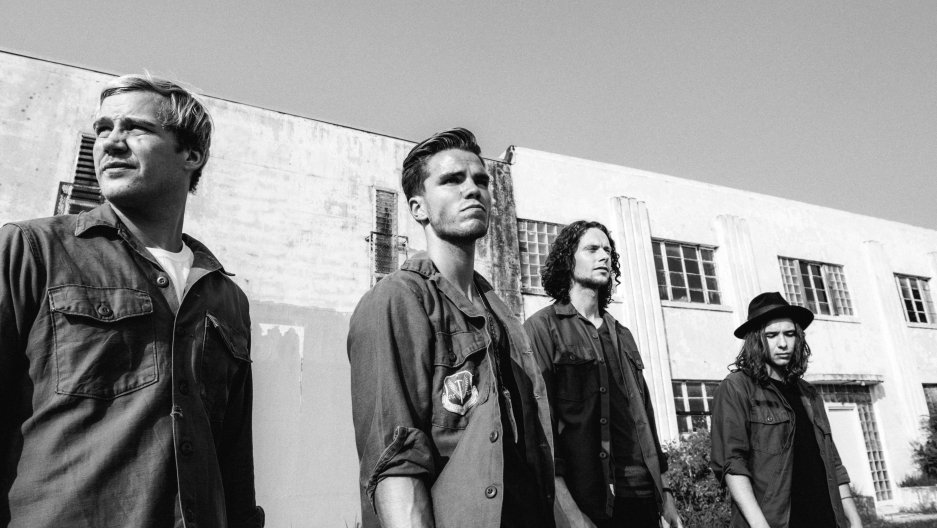
Every story has two sides, and that adage is certainly true for Kaleo, the four-piece band from Iceland who now call the US home. Call it a split upbringing: the isolated heritage that results from coming of age in Iceland has paired with the fresh inspiration of moving to America, and the band has built a sound to match the disparate landscapes. A gorgeous and raucous blend of rock, folk and blues, Kaleo’s debut LP embodies that very spirit of duality: titled A/B, the album showcases the band’s multi-layered dynamics and ability to play different genres with equal skill.
Best friends since attending elementary school outside of Reykjavik, bandleader JJ Julius Son, drummer David Antonsson, and bassist Daniel Kristjansson began playing together at the age of 17 before adding guitarist Rubin Pollock to the mix in 2012. They named the band Kaleo, which means “the sound” in Hawaiian, and started their career in with a handful of well-received shows at the 2012 Iceland Airwaves music festival. The band signed to Elektra/Atlantic and moved to the States in early 2015, choosing Austin as their new base.
“It has obviously been a big change coming from a small country of 300 thousand people in Iceland to the USA with over 300 million people,” says JJ Julius Son. “We’ve learned a lot, and we are more experienced now than when we first came. Overall it’s been a great adventure.” The past year has been a busy one for the band, as they’ve played nearly nonstop—including over 45 US states—as well as notching a spot on the soundtrack to HBO’s hit show Vinyl and recording a full length album with the producer Jacquire King in Nashville.
The concept behind A/B comes from Julius Son’s love of the split sides of vinyl records and their ability to showcase an artist’s different sides. “I write very different songs that many would like to label into different genres,” he says. “The idea of A/B is to show the diversity and the two sides of the band.” The “A” side is more rock and roll and blues (opener “No Good,” “Way Down We Go,” “Hot Blood”), while the “B” side is a bit softer with more ballads (“All the Pretty Girls,” “Vor I Vaglaskogi,” and closer “I Can’t Go On Without You”). But no matter which side you’re on and which song is playing, the sound can only be that of Kaleo.
A/B was primarily produced and recorded with King, the esteemed production icon whose past work with talented artists as varied as Tom Waits, Kings of Leon, Norah Jones, Buddy Guy, James Bay, and Of Monsters and Men helped Kaleo showcase both their louder and softer sides. In addition to the sessions in Nashville, Kaleo wrote and recorded in various other locales around their new home in the US as well as a few different sessions around the world, from their home of Iceland to Spain and London as well. Additional production contributions to the album in these various sessions came from Mike Crossey, Arnar Guðjónsson and the band.
Starting off A/B with a bang, “No Good” welcomes in the “A” side with its crunching, bluesy stomp-rock. Julius Son’s deep, raspy growl is perfectly paired to the band’s snarling assault, and sets the bar high for the rest of the record to come. “Kiss your baby goodbye,” he purrs, and with that, we’re off and running.
“Way Down We Go” is filled with bluesy angst and anchored by piano and rhythmic, pounding drumming. Julius Son’s vocals shift into the higher registers just as easily as they find their home at the bottom.
“All the Pretty Girls” leads off the “B” side, and in a sense it was the song that started it all for Kaleo in the beginning. In the spring of 2014, they recorded the lush, introspective song and in one night their destiny to outgrow their small, island nation was cemented, as it spread like wildfire across the airwaves.
“Vor I Vaglaskogi” is a traditional Icelandic love song, and the only one sung in the band’s native language. The song’s beauty and power transcend the fact that most in their newly found worldwide audience will not be able to understand it. And for Julius Son, that notion fits right in with how he likes his lyrics to be interpreted anyway.
“I prefer to let the listener decide what each song means to them instead of me telling my own personal connection,” he says. “Some of the songs are very personal for me, though—some more than others. But it seems that different people connect to songs in a different way, often based on personal experiences or things that you are going through at that time.”



HERE IS A GREAT REVIEW OF THERE NEWEST ALBUM
http://www.soundfiction.net/2016/06/10/album-review-kaleo-ab
